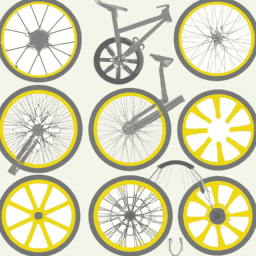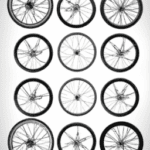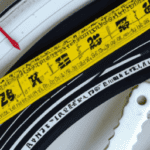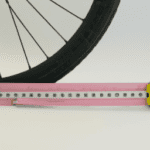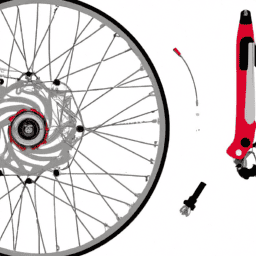When purchasing a bicycle, deciding on the wheel size is crucial. Although it might appear to be a minor aspect, the size of the wheels significantly affects your cycling experience.
As someone who has spent countless hours researching and testing different wheel sizes, I can tell you that it’s worth taking the time to understand the options and choose the right size for your needs.
In this article, I’ll walk you through the basics of wheel size measurements, the factors you should consider when choosing a size, and the pros and cons of different sizes.
Whether you’re a novice rider looking for your first bike or a seasoned cyclist in search of a new ride, this guide will help you make an informed decision about what wheel size is best for you.
So, let’s dive in and explore the world of bicycle wheel sizes.
Key Takeaways
- Choosing the right wheel size is crucial for a good riding experience and involves understanding wheel size measurements and considering factors like tire width, frame size, and intended use.
- Different wheel sizes offer different benefits depending on riding preferences and terrain conditions, and pros and cons of each size should be considered when making a decision.
- Test riding different wheel sizes and consulting with experts can help determine the appropriate size for you, as there is no one-size-fits-all solution.
- Taller and heavier riders may benefit from larger wheels, while smaller and lighter riders may prefer smaller wheels. Larger wheels offer less rolling resistance but are harder to maneuver, while smaller wheels have more rolling resistance but are easier to accelerate and maneuver.
Understanding Wheel Size Measurements
You’ll need to understand how wheel size measurements work to choose the right bicycle wheel size for you. Common misconceptions include thinking that bigger wheels are always better or that a specific wheel size is best for all types of terrain. However, the truth is that there are several factors to consider when choosing a wheel size, and each size has its own advantages and disadvantages.
When it comes to wheel size and terrain, a larger wheel size may be better for rolling over rough terrain and obstacles, but it may also be heavier and slower to accelerate. On the other hand, a smaller wheel size may be lighter and quicker to accelerate, but it may not roll over obstacles as easily.
It’s important to consider the type of terrain you’ll be riding on and your own personal preferences and riding style when choosing a wheel size. Factors such as tire width, frame size, and intended use also play a role in determining the appropriate wheel size for your bicycle.
By taking these factors into consideration, you can choose a wheel size that will provide the best balance of speed, control, and comfort for your riding needs.
Factors to Consider When Choosing a Wheel Size
When deciding on the ideal wheel size for your ride, taking into account factors such as riding preferences, terrain conditions, body size, and weight can greatly impact your cycling experience. Here are some things to consider:
-
Riding preferences: Do you prefer speed or comfort? Different wheel sizes offer different benefits depending on what kind of riding you enjoy. A larger wheel size is great for speed and efficiency on smooth terrain, while a smaller wheel size may provide more comfort on rough terrain.
-
Terrain conditions: What kind of terrain will you be riding on? If you plan to ride on rough or uneven terrain, a smaller wheel size may provide better control and stability. On the other hand, if you’ll be primarily riding on smooth roads, a larger wheel size may be more efficient.
-
Body size: Your height and weight can also impact your choice of wheel size. Taller riders may feel more comfortable on larger wheels, while smaller riders may prefer smaller wheels for a better fit and control.
-
Weight: Your weight can also impact your choice of wheel size. Heavier riders may benefit from larger wheels for better stability and strength, while lighter riders may prefer smaller wheels for easier maneuverability.
Considering these factors can help you make an informed decision when choosing the right wheel size for your bike.
In the next section, we’ll explore the pros and cons of different wheel sizes to help you make an even more informed choice.
Pros and Cons of Different Wheel Sizes
Are you wondering which wheel size will give you the best performance on different terrains and riding styles? Let’s explore the pros and cons of different wheel sizes.
First, let’s talk about rolling resistance. Larger wheel sizes generally have less rolling resistance, meaning they require less effort to maintain speed. However, this also means they have more rotational inertia, making it harder to accelerate and maneuver. Smaller wheel sizes, on the other hand, have more rolling resistance but are easier to accelerate and maneuver due to their lower rotational inertia.
Next, let’s consider maneuverability. Smaller wheel sizes, such as 26-inch or 27.5-inch wheels, are more maneuverable than larger wheel sizes. They are easier to handle on technical terrain and in tight spaces. Larger wheel sizes, like 29-inch wheels, are less maneuverable but offer better stability and momentum on rough terrain.
Ultimately, the best wheel size for you will depend on your riding style and the type of terrain you plan to ride on. Moving on to the subsequent section about recommendations for different types of riders, it’s important to note that there’s no one-size-fits-all answer. It’s best to consult with a bike expert or try out different wheel sizes to see what works best for you.
Recommendations for Different Types of Riders
When it comes to choosing the right wheel size for your bicycle, there’s no one-size-fits-all solution. As a rider, I’ve found it helpful to test ride different wheel sizes to see what feels most comfortable and efficient for my needs.
Additionally, consulting with experts and investing in quality components and maintenance can make a significant difference in the overall performance and longevity of your bike.
Test Riding Different Wheel Sizes
Try out different wheel sizes by taking them for a test ride and see which one feels the most comfortable for you. This is the best way to determine which wheel size is right for you because everyone has a different preference when it comes to ride experiences. Comparing ride experiences is key when you are figuring out what size wheel is right for you. You want to make sure that you are comfortable on the bike and that you feel stable when riding.
To help you decide which wheel size is best for you, consider the following table that breaks down the advantages and disadvantages of different wheel sizes. Remember that this table is just a guide, and the best way to know what wheel size is right for you is to take them for a test ride.
| Wheel Size | Advantages | Disadvantages |
|---|---|---|
| 26" | Lighter weight, easier to maneuver | Not as stable, less efficient on rough terrain |
| 27.5" | Good balance of weight and stability, efficient on most terrain | Not as fast as larger sizes |
| 29" | Most efficient on rough terrain, faster than smaller sizes | Heavier weight, harder to maneuver |
After test riding different wheel sizes and reviewing the table, you may still have questions about which size is right for you. In the next section, we will discuss consulting with experts who can help you make an informed decision.
Consulting with Experts
Consulting with experts is essential if you want to make an informed decision about which wheel size is perfect for your riding style and will make you feel like you’re gliding on clouds.
Expert opinions are critical because they can help you understand the nuances of different wheel sizes and how they can impact your riding experience. Additionally, they can provide you with valuable insights into industry standards and best practices, ensuring that you get the most out of your investment.
When seeking expert opinions, it’s important to find someone who has experience and knowledge about different wheel sizes. This could be a local bike shop mechanic or a professional rider who specializes in your preferred riding style.
By listening to their advice, you can confidently choose the wheel size that will best suit your needs and preferences. Investing in quality components and maintenance is also a crucial aspect of ensuring your bike performs optimally, and this will be discussed in the following section.
Investing in Quality Components and Maintenance
To ensure optimal performance and longevity for your ride, it’s essential to invest in high-quality components and regularly maintain them. Here are some tips to help you upgrade your bike components without breaking the bank:
-
Choose budget-friendly options: You don’t have to go for the most expensive components to get good quality. Look for mid-range options that offer a good balance between performance and cost. This way, you can upgrade multiple components without going beyond your budget.
-
Upgrade components over time: You don’t have to upgrade all your components at once. Start with the most critical ones such as the wheels, brakes, or drivetrain, and gradually upgrade the rest over time. This will allow you to spread the cost and make the most of your investment.
-
Regularly maintain your components: Even the best components will wear out over time if not maintained properly. Regular cleaning, lubrication, and adjustment will help extend the life of your components and ensure optimal performance.
-
Consult with experts: If you’re not sure which components to upgrade or how to maintain them, consult with experts such as your local bike shop or online forums. They can provide valuable insights and help you make informed decisions.
Frequently Asked Questions
How do I know which wheel size is best for my riding style?
Choosing the right wheel size depends on factors such as terrain and riding style. For example, a larger wheel provides better momentum on flat surfaces, but a smaller wheel may be better for technical terrain. It’s important to compare sizes and consider your specific needs.
Can I change the wheel size on my current bike?
Yes, you can change your bike’s wheel size, but it’s best to consult a bike mechanic to ensure compatibility with your frame. Pros include improved ride quality, while cons may include reduced clearance and altered handling. Tips for adjusting your bike to a different wheel size include adjusting brake and derailleur settings.
Are there any disadvantages to choosing a larger wheel size?
Choosing a larger wheel size can have both pros and cons. The increased diameter can improve rolling momentum and stability, but it may also impact performance in areas such as acceleration and maneuverability. It ultimately depends on personal preference and riding style.
What is the difference between a 26-inch and a 27.5-inch wheel?
The rim width comparison between 26-inch and 27.5-inch wheels is minimal, but the latter offers better rolling efficiency and improved traction. Tire options analysis shows more options for 27.5-inch wheels, but personal preference is important for choosing the right size.
Can I mix and match wheel sizes on my bike?
Mixing wheel sizes on a bike can cause compatibility issues. Interestingly, it’s estimated that only about 5% of bikes can safely accommodate different wheel sizes. It’s important to check with a professional before attempting to mix and match.
Conclusion
In conclusion, choosing the right wheel size is crucial to ensuring a comfortable and efficient ride. With an understanding of the measurements and factors to consider, riders can make informed decisions about which wheel size will work best for their needs.
While there are pros and cons to each size, it ultimately comes down to personal preference and the type of riding being done. When riding, it’s important to feel confident and in control, and having the right wheel size can make all the difference.
So, ask yourself, do you want the speed and agility of a smaller wheel, or the stability and comfort of a larger one? Whatever your answer may be, remember to take into account your riding style, terrain, and personal preferences.
With the right wheel size, you can feel confident and comfortable on any ride.
